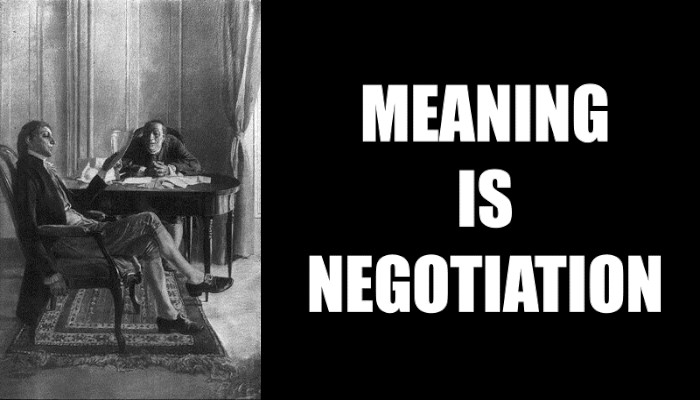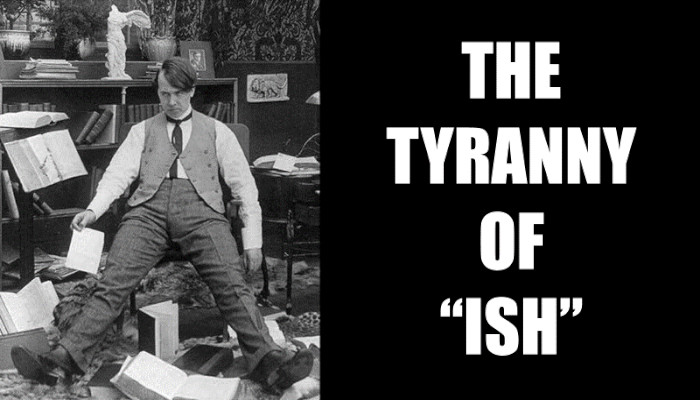by Ron Ploof | Jan 5, 2020 | Business Storytelling, Linguitics

Have you ever stated your case so clearly that you knew with certainty that you nailed it? And while you were celebrating your superior communication achievement, have you ever found yourself standing in front of someone who just didn’t get it…at all? If so, you’ve probably fallen victim to a metaphorical mismatch.
Humans use metaphor–the ability to define one thing in terms of something totally different–to understand complex ideas. Essentially, we build upon the concepts learned through the human condition.
Think about the concept of time. Everyone knows what time is because we experienced it everyday. However, if I pressed you to define it, I bet you’d struggle. Exactly how does one describe something we can’t see, hear, smell, touch, or taste?
That’s where metaphor comes in. Rather than describing time directly, we represent it metaphorically through the various ways it affects our lives. For example, we know that time has:
- Inevitability: There’s nothing that we can do to stop it
- Motion: Time moves from the past, through the present, and into the future
- Direction: We can look back in time to see where we’ve been and forward to predict where we’ll be
- Duration: We’re accustomed to waiting for a process to finish
- Distance: We describe long time durations in terms of distance, such as looking far into the future or way back in the past
- Physical effect: We are born young and small, then grow up to become big and old
- Value: We know that our time is limited, and therefore is a precious commodity. We’re even paid for our time.
Try finding a few of your own.
The concept of time is so deep, it’s highly likely that all metaphorical references won’t be shared among all people. For example, an old person with less time in front of them may disagree with the statement that “There will be plenty of time to do X, Y, or Z.” . Or, no matter how much truth contained in “Don’t worry, things will get better with time,” someone who’s just suffered a tremendous loss won’t react well to the statement.
If your audience doesn’t believe in the metaphorical bricks that you have built your premise upon, your idea will not only be dead on arrival, but your ability to share your concept will suffer a setback. Consider the worldviews of our example old and young people. By definition, the former has more life experience than the latter, yet many of those life experiences don’t align. While the older person has lived through their twenties, they didn’t live through the twenties in this century. Thus, by choosing to communicate using 20th-century metaphors on 21st-century belief systems risks instant slap-backs, as in with the trendy “Okay, Boomer.”
Metaphor is a negotiation because it requires speakers to understand the worldview of their listeners before stating a case. Without understanding your listener’s metaphorical belief structure, it’s easy to step into a hornets nest of misinterpretation.
The conveyance of meaning is fickle because we each interpret information differently. Your goal as a communicator is to find the best metaphor through testing and conversation. If you can find a similar–not necessarily identical–life experience to build your complex concept upon, you’ll have found a successful frame of reference to base your argument.
Photo Credit: Benjamin Franklin and Richard Oswald discussing the Treaty of Peace Paris. , 1898. Photograph. https://www.loc.gov/item/2004674949/.
by Ron Ploof | Nov 11, 2019 | Linguitics

I was presenting to a live online audience, had just explained Kendall Haven’s assertion that all humans learn through story structure, and then supported his claim with an example built upon Kenn Adams’ Story Spine.
Once upon a time there was a baby girl.
Everyday, someone comforted her when she cried.
Then one day, she cried and nobody came.
And because of that, she cried louder.
And because of that, she cried even louder.
Until finally, she noticed something. When it’s light outside, people comfort her. When it’s dark outside, they don’t.
And ever since then, she learned to sleep through the night.
The example illustrates how humans build new knowledge on top of existing knowledge by rectifying the differences between expected vs. actual outcomes.
After completing the example, I blurted some superlative like, “See what I mean? That’s exactly right.”
Evidently, someone in the audience took offense to my loose word-choice and typed, “Those with kids are not sure that’s *exactly* correct,” into the webinar’s live commenting system.
OMG. “That’s what you took from that?” I thought to myself. Putting aside the fact that my wife and I have raised two children–thank you very much–I wasn’t saying that ALL children learn to sleep through the night this way. I was demonstrating how people translate anomalies in their expectations into new knowledge through story structure. And while I obviously could have been clearer by tightening up my vague pronoun reference–which I likely would have caught had I been writing instead of speaking–this text-based critique felt familiar.
Recently, I’ve noticed a popular trend to focus on the literal as opposed to the figurative. When faced with a new idea, it’s popular to chip at its edges rather than focus on the main point. A shift in cultural norms has made it fashionable to major in minor things, sweat the small stuff, and dismiss arguments based on exceptions instead of the rules.
Historically, there have been two ways to deal with nitpickers: hold firm on the analogy’s main point or kowtow. The consequences of the latter are chilling. If humans are afraid to share new ideas, we lose the ability to communicate–the lifeblood of human interaction. And so, perhaps as an unintended consequence of this fear, a third option has emerged–a linguistic countermeasure designed to shield communicators from the snipers.
Here’s how it works. You start with an assertion like:
Diving into the shallow end of the pool is dangerous.
Then you soften the statement with a suffix, like this:
Diving into the shallow end of the pool is dangerous…ish.
“Ish” has become shorthand for “don’t shoot me if my statement doesn’t cover one hundred percent of your logical scenarios.” Had I been savvy enough to incorporate it into my talk by saying, “That’s exactly right…ish,” I would have insulated myself from the inflexibility of logic unabated. But, it also would have also watered down the concept I was trying to convey.
Let’s consider the effect of “ish” on the following sentences:
That’s just like the last time we went camping…ish.
He looks like George Clooney…ish.
Your hair is brown…ish.
This product is superior…ish.
That was the best movie ever…ish.
“Ish” is like a good-news-bad-news joke. The good news is that it holds the logic-snipers at bay. The bad news is that it debilitates strong statements.
I wrote an entire book on writing strong statements, so let’s see what happens when we “ish” a few proverbs.
A clean conscience makes a soft pillow…ish
Charity begins at home…ish
Discretion is the better part of valor…ish
Laughter is the best medicine…ish.
Lightning never strikes twice in the same place…ish
Oil and water don’t mix…ish
Old friends and old wine are best…ish
Patience is a virtue…ish
Communicating big concepts frequently requires speakers to employ meaning-approximation devices like simile, analogy, and metaphor. Unfortunately, since all will ultimately breakdown when exposed to the corrosive environment of pure logic, they’ve somehow become easy targets for those who choose to toil in the rhetorical margins.
The tyranny of “ish” is clear. Eroding our ability to convey deeper meaning inhibits our ability to think. For that reason alone, the practice must be stopped. Yet, to do so, we must attack “ish” on two fronts. First, communicators must hold firm on the message–refusing to kowtow to the logical snipers. Second, audiences must extend the benefit of the doubt. Rather than attacking an argument’s weak flanks with a barrage of Lilliputian attacks, what if we actually gave analogies, similes, and metaphors a little chance to breathe first?
Or we could just continue to lob hand grenades at them from the corners…ish.
Photo Credit: Translating a love letter from a Boston girl – “Now, does that mean yes or no?”. , ca. 1903. Photograph. https://www.loc.gov/item/2004668492/.

